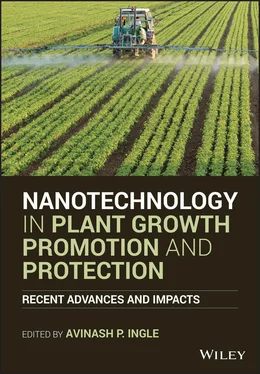1 Cover
2 Title Page
3 Copyright Page
4 List of Contributors
5 Preface
6 1 Nanotechnology as a Smart Way to Promote the Growth of Plants and Control Plant Diseases: Prospects and Impacts 1.1 Introduction 1.2 Nanofertilizers 1.3 Nanopesticides and Nanoantimicrobials 1.4 Conclusions References
7 2 Effects of Titanium Dioxide Nanomaterialson Plants Growth 2.1 Introduction 2.2 Properties of TiO 2NPs Important for Biological Interaction 2.3 Pathways and Interaction of TiO 2NPs with Plants 2.4 Effect of Different Concentrations of TiO 2NPs on Plants 2.5 Benefits of Using TiO 2NPs Alone and in Complex Formulations on Plant Growth and Yield 2.6 Conclusion and Future Perspective Acknowledgement References
8 3 The Emerging Applications of Zinc‐Based Nanoparticles in Plant Growth Promotion 3.1 Introduction 3.2 Applications and Effects of Zn Based NPs on Plant Growth Promotion 3.3 ZnO NPs in Enhanced Plant Growth 3.4 Zn NPs in Crop Protection 3.5 Conclusions References
9 4 Nanofertilizer in Enhancing the Production Potentials of Crops 4.1 Introduction 4.2 Nanofertilizers 4.3 Synthesis of Nanofertilizer 4.4 Uptake, Translocation, and Fate of Nanofertilizers in Plants 4.5 Percolation Studies to Assess Nutrient Release Pattern 4.6 Application of Nanofertilizers in Plants 4.7 Specific Properties of Nanofertilizers 4.8 Biosafety Issues in Nanofertilizer Application 4.9 Nanofertilizer Studies at Tamil Nadu Agricultural University (TNAU) 4.10 Conclusion References
10 5 Potential Applications of Nanobiotechnology in Plant Nutrition and Protection for Sustainable Agriculture 5.1 Introduction 5.2 Nanomaterial in Sustainable Crop Production 5.3 Nanomaterials in Crop Improvement 5.4 Nanomaterials in Plant Genetic Engineering 5.5 Future Perspectives and Challenges 5.6 Conclusions Acknowledgments References
11 6 Immunity in Early Life 6.1 Introduction 6.2 Nano Frontiers in Agricultural Development 6.3 Nanotechnology in Agriculture 6.4 Immunity in Early Life 6.5 Nanotechnology in Soil Feed and Waste Water Treatment 6.6 Conclusions References
12 7 Effects of Natural Organic Matter on Bioavailability of Elements from Inorganic Nanomaterial 7.1 Introduction 7.2 Effect of Natural Organic Matter on Nanoparticles' Aggregation and Agglomeration 7.3 Natural Organic Matter Effects on Nanoparticles' Dissolution 7.4 Effect of Mutual Interactions of Natural Organic Matter and Nanoparticles on Their Bioavailability 7.5 Conclusions Acknowledgment References
13 8 Induction of Stress Tolerance in Crops by Applying Nanomaterials 8.1 Introduction 8.2 Impact of Stress on Crops 8.3 Impact of Nanomaterials on Crops 8.4 Conclusions References
14 9 Nanoparticles as Elicitors of Biologically Active Ingredients in Plants 9.1 Introduction 9.2 Routes of Exposure, Uptake, and Interaction of NPs into Plant Cells 9.3 Elicitation of BAIs of Plants by Nanoelicitors 9.4 Mechanism of Action of Nanoelicitors 9.5 Conclusions References
15 10 Dual Role of Nanoparticles in Plant Growth and Phytopathogen Management 10.1 Introduction 10.2 Nanoparticles: Notion and Properties 10.3 Mode of Entry, Uptake, Translocation and Accumulation of Nanoparticles in Plant Tissues 10.4 Nanoparticle–Plant Interactions 10.5 Impact of Nanoparticles 10.6 Conclusions References
16 11 Role of Metal‐Based Nanoparticles in Plant Protection 11.1 Introduction 11.2 Nanotechnology in Agriculture 11.3 Metal‐Based Nanoparticles in Plant Protection 11.4 Possible Antimicrobial Mechanisms for Metal‐Based Nanoparticles 11.5 Conclusions Acknowledgment References
17 12 Role of Zinc‐Based Nanoparticles in the Management of Plant Diseases 12.1 Introduction 12.2 Plant Diseases and Their Symptoms 12.3 Importance of Zn for Plants 12.4 Distribution of Zn in Plants 12.5 Efficiency of Zn in Plants 12.6 Deficiency Symptoms 12.7 Effects of Zn on Microbial Activity 12.8 Nanotechnology and Agriculture 12.9 Zn‐Based Nanoparticles in Plants 12.10 Conclusions References
18 13 Effects of Different Metal Oxide Nanoparticles on Plant Growth 13.1 Introduction 13.2 Effects of Nanoparticles on Plant Growth and Development 13.3 Mechanisms of Nanoparticles and Plant Interactions 13.4 Conclusions Acknowledgment References
19 14 Biostimulation and Toxicity: Two Levels of Actionof Nanomaterials in Plants 14.1 Introduction 14.2 Induction of Biostimulation or Toxicity in Plants Due to the Physical Properties of the NMs 14.3 Induction of Biostimulation or Toxicity in Plants Due to the Chemical Properties of NM Core and the Composition of Corona 14.4 Examples of Biphasic Phenotypic Responses of Plants to Nanomaterials Concentration 14.5 Conclusions References
20 15 Toxicological Concerns of Nanomaterials in Agriculture 15.1 Introduction 15.2 Uptake and Translocation of Nanomaterials 15.3 Mechanisms and Factors Affecting Uptake and Translocation of Nanomaterials 15.4 Nature and Factors Affecting Nanomaterial Phytotoxicity 15.5 Non‐Metallic Nanomaterials 15.6 Metallic Nanoparticles 15.7 Alteration of Toxic Effects Caused by Nanomaterials; Co‐Exposure Experiments 15.8 Effects of Nanomaterials on Enzymatic and Non‐Enzymatic Defense Systems 15.9 Antioxidant‐Mediated Removal of Reactive Oxygen Species (ROS) 15.10 Effects of Nanomaterials on Micro and Macro Organismal Communities Associated with Soil in Agroecosystems 15.11 Conclusions References
21 Index
22 End User License Agreement
1 Chapter 2 Table 2.1 Influence of TiO 2nanoparticles on plants, seed treatment. Table 2.2 Influence of TiO 2nanoparticles on plants, hydroponic exposure. Table 2.3 A influence of TiO 2nanoparticles on plants grown in soil.
2 Chapter 3 Table 3.1 Effects of Zn NPs on germination and seedling growth after applicat... Table 3.2 Effects of Zn NPs on plant growth and promotion applied through dif...
3 Chapter 6Table 6.1 Nanomaterials and their role in plant growth and disease resistance...
4 Chapter 8Table 8.1 Abiotic stress tolerance induced by different nanomaterials.Table 8.2 Biotic stress tolerance induced by different nanomaterials.
5 Chapter 9Table 9.1 Summary of the effects of different types of nanoparticles used as ...Table 9.2 Summary of the effects of different types of nanoparticles used as ...Table 9.3 Summary of the effects of different types of nanoparticles used as ...Table 9.4 Summary of the effects of different types of nanoparticles used as ...
6 Chapter 12Table 12.1 Concentration of Zn in different plants.Table 12.2 Different type of Zn‐based nanoparticle and their properties.
1 Chapter 2 Figure 2.1 Three main ways of TiO 2nanoparticle applications with their diff...
2 Chapter 3 Figure 3.1 Outline of different methods used for the treatment of seeds with... Figure 3.2 Translocation and major physiological and biochemical responses o...
3 Chapter 4Figure 4.1 Schematic illustration of percolation reactor.Figure 4.2 Nitrate‐loaded nano‐zeolite: Characterization, nutrient release, ...
4 Chapter 5Figure 5.1 Schematic illustration of various nano‐based products useful in a...Figure 5.2 NPs based plant transformation for crop improvements.
5 Chapter 6Figure 6.1 Nanotechnology applications, nanoforms, and nanoagronomics benefi...
6 Chapter 8Figure 8.1 Main stress conditions in agricultural crops and their effects.Figure 8.2 Signaling pathways in plants under abiotic stress. The black arro...Figure 8.3 Impacts of nanomaterials on plants, and responses to generate tol...
7 Chapter 9Figure 9.1 Classification of commercially and pharmaceutically important bio...Figure 9.2 Graphical representation of different types of nanomaterials whic...Figure 9.3 Schematic illustration of the different courses of uptake, entry,...Figure 9.4 Representation of a proposed mechanism involved in nano‐elicited ...
Читать дальше












